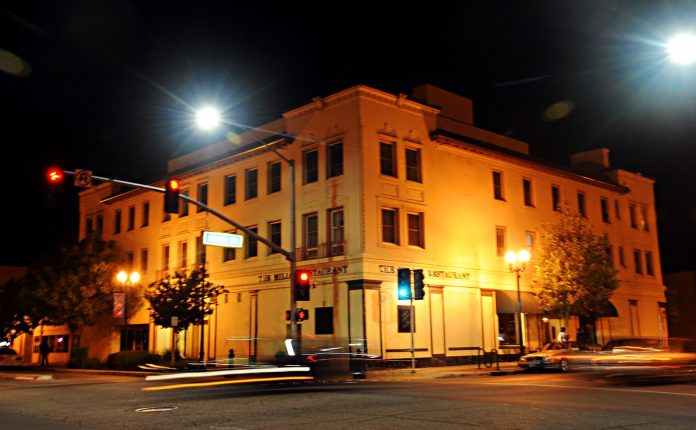The city has embarked on a multi-million-dollar capital improvement project in downtown Gilroy, but some business owners say it’s costing them money, too.The proprietors of the Milias Restaurant and Hotel estimate they lost thousands of dollars in potential revenue between Dec. 1 and 5 after a weeklong construction project drove away customers during what’s traditionally the busiest month in the restaurant business.
Along Eigleberry Street between First to 10th streets, contractors are replacing nearly century-old water lines under a contract with the city. After that part of the package is complete—expected to wrap up early in the New Year—Eigleberry Street will be dug up, patched and re-paved in the spring.
“The last time the street was done was in the 1920s,” City Transportation Engineer Henry Servin said.
A hodgepodge of different sidewalks surrounding the Milias, located at the corner of Sixth and Monterey streets, will be replaced and standardized with the rest of downtown in February. The streetlights at the intersection will be replaced with ornamental LED streetlights—which save money on electricity costs and provide better, clearer lighting, Servin said.
But Milias co-owners Adam Sanchez and Ann Zyburra told the Dispatch that having contractors block off the intersection of Sixth and Eigleberry streets for the water line project cut thousands of dollars from their bottom line—after would-be customers turned elsewhere when they saw construction.
“All our parking was gone, and parking is already bad enough in downtown Gilroy,” Sanchez said. “Some very good customers of mine said they came by, drove around three times and went somewhere else. We heard that all week.”
The city notified businesses and residents who would be affected by the construction via a letter.
“It’s not that we’re pissed off they’re doing the work; it has to be done,” Sanchez continued. “I just wish they worked with us a little closer.”
The lunch crowd suffered the most, Sanchez added, but some dinner customers assumed the construction went on into the night. Work at the intersection on the water line wrapped up by 3:30 p.m. as a consideration to downtown businesses, according to Servin.
The city installed a changeable message sign adjacent to the Milias on Sixth Street that displayed a message reading “business open during construction.” Sanchez said they appreciated the gesture—it shows the city is trying, he explained—but there is still room for improvement.
“With our infrastructure being as old as it is, there has to be more interaction than just a letter to businesses,” Zyburra said. “If it’s an emergency—say a water main bursts—we’ll all have to deal with it. But if there’s going to be a physical shut down, (someone from the city) could come in, sit down and say, ‘Here’s the worst case scenario. How is this going to affect you?’ Ultimately, it affects the city’s tax dollars. If we’re closed, we’re not generating income and they’re not generating sales tax.”
Delays and inconveniences are inevitable with capital improvement projects, Servin said, but the city was sensitive to the fact construction could have an impact on business.
“You have to get to it and the best way to do it is in half-street portions,” he added.
Looking to the future, Sanchez and Zyburra agree that if city personnel have the time—and if and when it’s feasible—talking with business owners face-to-face about upcoming construction projects that will have an impact on business would go a long way to improving dialogue between City Hall and downtown.
“I would love to be able to go to council meetings, but I have a business that runs at night,” Zyburra added. “In an ideal situation, I’d go to all the meetings and be more involved.”
“I don’t like it to appear like we’re asking for special favors, but the downtown is the heart of the community,” she continued. “This downtown’s heart is in need of intensive care. People don’t need a reason to not come downtown.”
Sanchez suggested contractors hold off on the water line project until after the holidays, simply because December is the busiest month for restaurants, but noted that the damage is done.
“It’s done and over with,” Sanchez said Wednesday, adding that contractors completed the portion of the water line project at the intersection of Sixth and Eigleberry streets. “It hurt us the first week of December and hopefully they don’t start anything again until Jan. 1. That would be ideal.”
The re-paving project on Eigleberry Street won’t begin until February and the sidewalks at the Milias will be replaced between March and May, according to Servin.
With the right mixture of collaboration, communication and a mutual respect between the city and business owners, Sanchez is optimistic downtown can flourish. He’s been a part of Gilroy since 1967, and even then downtown had a problem it’s still wrestling with today—parking.
According to Sanchez, the combination of hard-to-find parking and a general perception of downtown as an unsafe place to be make it hard to do business downtown. But if the city and downtown business owners work together on a solution to the decades-old problem, Gilroy would turn a corner, he said.
“If you go to your favorite restaurant, will you leave if you can’t find parking out in front? If I could park in the front of every restaurant I wanted to go to in San Francisco, it would be a miracle. I always know I’ve got to park somewhere else and walk in,” Sanchez said. “Gilroy doesn’t do that. They don’t want to walk. They’ll drive around and go somewhere else if they can’t find parking. I think it’s the perception of ‘what if I have to park over there in the dark.’ We’ve got to do something about that perception.’”














